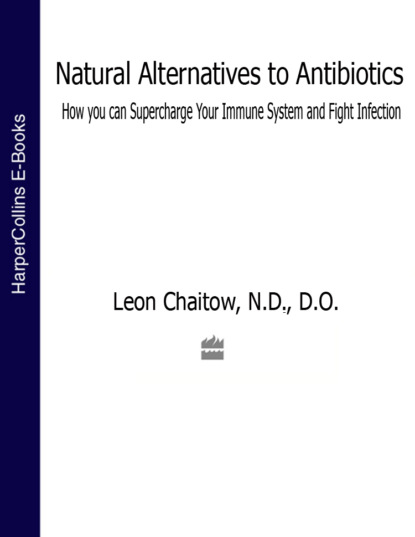По всем вопросам обращайтесь на: info@litportal.ru
(©) 2003-2024.
✖
Natural Alternatives to Antibiotics: How you can Supercharge Your Immune System and Fight Infection
Автор
Год написания книги
2019
Настройки чтения
Размер шрифта
Высота строк
Поля
This bacterium is present in almost everyone, usually living in the nose. It is commonly involved in infections of
the skin (boils and abscesses, for example)
conjunctiva of the eyes (conjunctivitis).
When it has entered the body, often in a hospital, possibly after surgery, it can be the major cause of infections of;
the lungs (pneumonia)
the brain (meningitis)
the bones or bone marrow (osteomyelitis)
the heart (endocarditis).
Or it can be involved in some horrendous, often fatal, conditions such as:
Toxic Shock Syndrome
Scalded Skin Syndrome (SSS), in which the skin sloughs off the body as though it had been burned.
In both SSS and Toxic Shock Syndrome there seems to be a combined involvement of Staphylococcus aureus and a potentially dangerous yeast, Candida albicans (which lives in everyone on the planet, usually harmlessly). Candida often proliferates in the intestinal tract after antibiotic use, when its natural controls, including the flora of the bowel, are damaged.
Dr. Eunice Carlson of Michigan University has shown that when Candida is actively present in the system at the same time as an infectious agent such as Staphylococcus aureus, the toxic effects of Staphylococcus aureus are hugely enhanced and can result in fatal Toxic Shock Syndrome.
As time has passed, Staphylococcus aureus has become resistant to almost all antibiotics apart from Vancomycin, which is now used specifically for the purpose of controlling it.
Vancomycin has potentially dangerous side-effects, is difficult to administer (usually via a drip) and is costly. This is the only remaining Staphylococcus aureus antibiotic. If resistance to vancomycin also develops, as is almost certain in time, there are no other antibiotic treatment methods currently available.
Other commonly resistant (to antibiotics) staphylococci include Staph, epidermidis and Staph, haemolyticus. Widespread, hospital-acquired infections involving these bacteria are now commonly treated with vancomycin, although this is often an inappropriate means of controlling them, according to leading experts.
As Professor French and Emeritus Professor Phillips, both of the Department of Microbiology at St. Thomas’s Hospital, London, say, ‘These infections often do not require antibiotic therapy, and unnecessary use of vancomycin for these organisms may be one factor in the emergence of … resistance.
They believe that as these staphylococci acquire resistance to vancomycin they may be able to transfer this to the far more dangerous organism Staphylococcus aureus. Were this to happen, these researchers state, ‘Serious, untreatable staphylococcal infection would result.’
Once again we see, despite all the warnings that have been given, as well as the experience of the past, that inappropriate treatment is being used, with potentially disastrous consequences in store. Particular antibiotics are being used where they should not be used, and as a result resistance is likely to grow to the one antibiotic that can still control S. aureus.
CORYNEFORM BACTERIA
These bacteria are normally harmlessly present on almost everyone’s skin. In most cases they are sensitive to antibiotics. However, in hospital settings patients often become colonized with resistant strains and species which can then cause infections – if there is an opportunity, something far more likely in hospital settings, for any number of reasons including the obvious one that people in the hospital are more prone to having lowered immunity because they are already ill.
Infection with Coryneform Bacteria is most common where catheters and prostheses are involved, or in patients whose immune systems are struggling because of various blood-related and malignant diseases.
In hospitals Coryneform Bacteria are now resistant to most antibiotics and respond only to vancomycin.
STREPTOCOCCUS PNEUMONIAE
These bacteria, as their name suggests, are often involved in pneumonia, but they may also cause meningitis and are often associated with infections of the sinuses, ears, blood, and lungs.
When only low levels of resistance are found in the bacteria, high doses of penicillin will still control infections in which they are involved. However for those strains which have developed resistance to many antibiotics the treatment commonly involves the powerful drug vancomycin, or a cephalosporin antibiotic such as cefoxtaximine.
Researchers note that there are now signs that this last-mentioned class of drugs are gradually losing their power to control the bacteria, and there are major fears that this resistance will increase over time.
ENTEROCOCCI
These organisms live mainly in the bowel and may become involved in infections of this region. They can also cause infections of:
the blood (bacteraemia)
the heart muscle (endocarditis)
the urinary tract
the endometrium in the uterus.
They are frequently involved with infection associated with the use of catheters (obviously something more likely to be happening in the hospital than anywhere else), as well as in peritonitis.
In hospital settings the particular bacteria from this group which are most commonly found to be involved in serious infection are Enterococcus faecalis and Enterococcus faecium. The latter, which in the past has been considered relatively unimportant and not dangerous (and easily controlled), is now found to be increasingly resistant to most antibiotics.
To quote Professors French and Phillips, ‘These organisms are among the most important and problematic multidrug resistant pathogens of the 1990s.’
HAEMOPHILUS INFLUENZAE
This is frequently associated with infections of the:
throat
sinuses
ears
bones and joints
chest
meninges of the brain
and sometimes breast infections in women (mastitis).
This organism has gradually increased its resistance to the major drugs used to control it, including ampicillin. In one major incident in Spain in the early 1980s, resistance was demonstrated to chloramphenicol and ampicillin by around 60 percent of Haemophilus influenzae strains found in patients with meningitis.
It is, however, still very susceptible to antibiotics such as cefuroximine and cefaclor, although even in these a small degree of resistance is now being reported.
NEISSERIA GONORRHOEA
This organism is involved in:
sexually transmitted diseases such as gonorrhea









